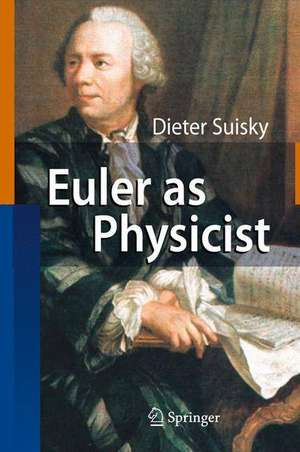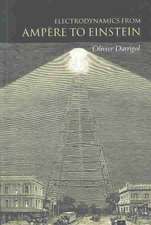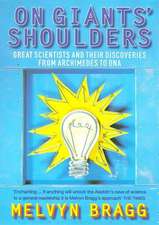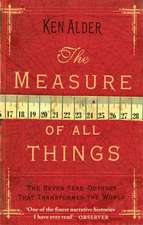Euler as Physicist
Autor Dieter Suiskyen Limba Engleză Hardback – 23 dec 2008
| Toate formatele și edițiile | Preț | Express |
|---|---|---|
| Paperback (1) | 643.65 lei 6-8 săpt. | |
| Springer Berlin, Heidelberg – 19 oct 2010 | 643.65 lei 6-8 săpt. | |
| Hardback (1) | 650.04 lei 6-8 săpt. | |
| Springer Berlin, Heidelberg – 23 dec 2008 | 650.04 lei 6-8 săpt. |
Preț: 650.04 lei
Preț vechi: 764.76 lei
-15% Nou
Puncte Express: 975
Preț estimativ în valută:
124.39€ • 133.01$ • 103.71£
124.39€ • 133.01$ • 103.71£
Carte tipărită la comandă
Livrare economică 18 aprilie-02 mai
Preluare comenzi: 021 569.72.76
Specificații
ISBN-13: 9783540748632
ISBN-10: 3540748636
Pagini: 440
Ilustrații: XXIV, 338 p.
Dimensiuni: 156 x 235 x 30 mm
Greutate: 0.69 kg
Ediția:2009
Editura: Springer Berlin, Heidelberg
Colecția Springer
Locul publicării:Berlin, Heidelberg, Germany
ISBN-10: 3540748636
Pagini: 440
Ilustrații: XXIV, 338 p.
Dimensiuni: 156 x 235 x 30 mm
Greutate: 0.69 kg
Ediția:2009
Editura: Springer Berlin, Heidelberg
Colecția Springer
Locul publicării:Berlin, Heidelberg, Germany
Public țintă
ResearchCuprins
The Predecessors: Descartes, Newton and Leibniz.- Newton and Leibniz on Time, Space and Forces.- Newton and Leibniz on the Foundation of the Calculus.- Euler’s Program for Mechanics.- The Foundation of the Calculus.- Euler’s Early Relativistic Theory.- Euler’s Wirksamkeit, Helmholtz’s Treatment of Energy Law and Beyond.- Euler’s Mechanics and Schrödinger’s Quantum Mechanics.
Recenzii
From the reviews:
"A leading mathematician of the 18th century, Leonhard Euler made innovative contributions to mechanics that laid the foundations of mathematical physics that are still in use today. … In this work written for professionals in the physical sciences, Suisky … lays out the details of simultaneous 18th-century advances in both mechanics and mathematics, with some later chapters devoted to 19th- and 20th-century applications. … Summing Up: Recommended. Researchers, faculty, and professionals." (F. Potter, Choice, Vol. 46 (11), August, 2009)
"A leading mathematician of the 18th century, Leonhard Euler made innovative contributions to mechanics that laid the foundations of mathematical physics that are still in use today. … In this work written for professionals in the physical sciences, Suisky … lays out the details of simultaneous 18th-century advances in both mechanics and mathematics, with some later chapters devoted to 19th- and 20th-century applications. … Summing Up: Recommended. Researchers, faculty, and professionals." (F. Potter, Choice, Vol. 46 (11), August, 2009)
Textul de pe ultima copertă
"Euler as Physicist" analyzes the exceptional role of Leonhard Euler (1707 - 1783) in the history of science and emphasizes especially his fundamental contributions to physics. Although Euler is famous as the leading mathematician of the 18th century, his contributions to physics are as important for their innovative methods and solutions. Several books are devoted to Euler as mathematician, but none to Euler as physicist, like in this book.
Euler’s contributions to mechanics are rooted in his life-long plan presented in two volume treatise programmatically entitled "Mechanics or the science of motion analytically demonstrated". Published in 1736, Euler’s treatise indicates the turn over from the traditional geometric representation of mechanics to a new approach. In writing Mechanics Euler did the first step to put the plan and his completion into practice through 1760. It is of particular interest to study how Euler made immediate use of his mathematics for mechanics and coordinated his progress in mathematics with his progress in physics. Euler's mechanics is not only a model for a consistently formulated theory, but allows for generalizations of Euler's principles.
It is shown that even problems in contemporary physics may be advantageously reconsidered and reformulated in terms of Euler's early unified approach. The interplay between physics and mathematics which appeared in the 18th century is compared to the development of physics in the 20th century, especially to the development of quantum mechanics between 1900 and 1930. The author aims to show how Euler' work represents a rare example of a simultaneous and harmonic composition of results of different origin and nature which have been joined into a unique and marvellous result.
Euler’s contributions to mechanics are rooted in his life-long plan presented in two volume treatise programmatically entitled "Mechanics or the science of motion analytically demonstrated". Published in 1736, Euler’s treatise indicates the turn over from the traditional geometric representation of mechanics to a new approach. In writing Mechanics Euler did the first step to put the plan and his completion into practice through 1760. It is of particular interest to study how Euler made immediate use of his mathematics for mechanics and coordinated his progress in mathematics with his progress in physics. Euler's mechanics is not only a model for a consistently formulated theory, but allows for generalizations of Euler's principles.
It is shown that even problems in contemporary physics may be advantageously reconsidered and reformulated in terms of Euler's early unified approach. The interplay between physics and mathematics which appeared in the 18th century is compared to the development of physics in the 20th century, especially to the development of quantum mechanics between 1900 and 1930. The author aims to show how Euler' work represents a rare example of a simultaneous and harmonic composition of results of different origin and nature which have been joined into a unique and marvellous result.
Caracteristici
Several books are devoted to Euler as mathematician, but none to Euler as physicist, like in this book Includes supplementary material: sn.pub/extras
















